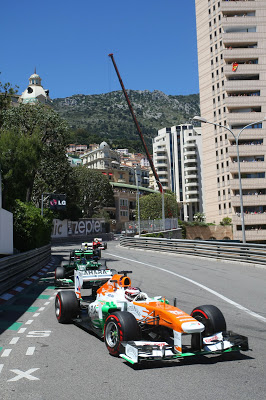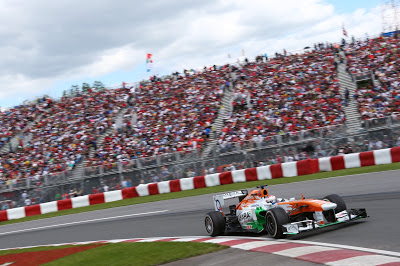By: William Ponissi
Digital Media & Website Coordinator at Formula One
 One of the biggest challenges in Formula One is brought by the incredible diversity of the circuits making up the World Championship calendar. With each track having its own layout and characteristics, the designers at Sahara Force India work in close collaboration with our engineers and workshop to produce solutions that help our car, the VJM06, adapt to the unique demands of each race.
One of the biggest challenges in Formula One is brought by the incredible diversity of the circuits making up the World Championship calendar. With each track having its own layout and characteristics, the designers at Sahara Force India work in close collaboration with our engineers and workshop to produce solutions that help our car, the VJM06, adapt to the unique demands of each race.
Never is this challenge more evident than at the end of spring, when the Formula One circus moves from the slowest, twistiest track on the calendar – the street circuit of Monaco - to one of the fastest, hosted on the flowing, tree-lined avenues of Montreal, Canada. With one circuit requiring our cars to perform at their best in 90-degree turns, hairpins and tight corners and the other asking for a flowing profile that reduces drag, there is the requirement for a big supply of new aerodynamic parts in a very short time.
At Sahara Force India we are lucky to be working in partnership with 3D Systems and to have access to their top-of-the-range iPro 9000 delivering SLA printing and ProJet 5000 with its MultiJet printing. These machines are vital allies in approaching every race, and this specific part of our season in particular.

In advance of such a crucial juncture in the year, the brains in our design office come up with all the ideas for aerodynamic appendages that can bring an advantage in Monaco and Montreal. Wing elements, car body parts – every single item of the VJM06 is analysed to see where any gain can be made. But theory, no matter how in-depth, needs to be supported by real-life testing – and here’s where 3D printing steps in.
With its huge savings in terms of both time and cost, this technique allows us to turn each one of these ideas – and in turn, several slightly different iterations of each one – into a real item, made with advanced ceramic-filled resins that behave in the same way as the materials our full-sized car is built of. The resulting models, each a tiny variation from the other to give us a full spectrum of options, are then sent for testing in our wind tunnel, where expert personnel is able to establish whether the theoretical hypotheses are correct, and which one among the variations offers the best results. The data then goes back to the design office for a refinement of the original ideas before the process is repeated. Such a process would, without 3D printing, take up months: with the 3D Systems machines, we can do this in a matter of days.
In the run up to Monaco, working with 3D Systems products helped us develop new aerodynamic appendages that maximised our downforce, allowing our drivers Adrian Sutil and Paul Di Resta to finish in point-awarding positions. New profiles designed with the Montreal track in mind allowed them to repeat the feat during our first foray in North America in 2013, helping the team build up a total of 51 points in seven races – our best ever start of a season.
With the Championship entering its crucial summer months, with prestigious events like the British Grand Prix on the calendar, every ounce of performance that these 3D printed parts help bring can be the one pushing the team to its aim of a podium finish!
